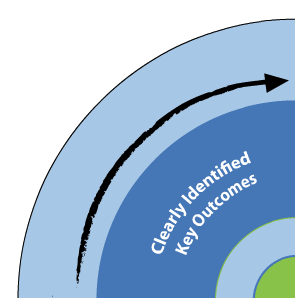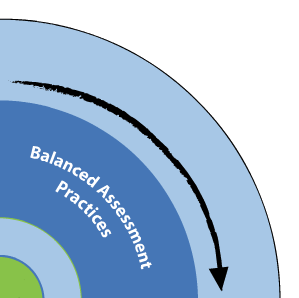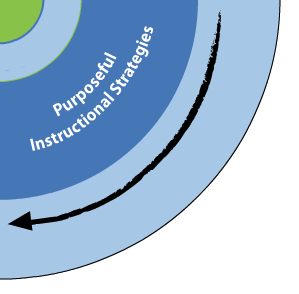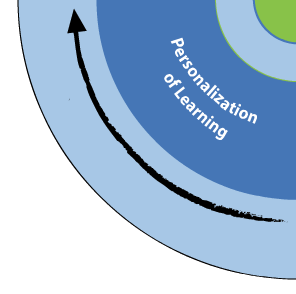Word Automaticity
Page Navigation
(Click to jump to section)
| Brief Explanation | Research | Characteristics of a Skilled Reader | Clearly Identified Key Outcomes | Balanced Assessment Practices | Purposeful Instructional Strategies | Personalization of Learning |
Brief Explanation
Automaticity is defined as accurate and effortless word identification at the single word level. A fluent reader has developed automaticity or the ability to read and recognize words quickly.
Research
- Fluent readers are able to read orally with speed, accuracy, and proper expression (National Reading Panel, 2000).
- When students possess automaticity, they do not have to attend to the task of decoding and can focus on the meaning of the text (Tankersley, 2003; Vaughn & Linan-Thompson, 2004). Fluency is a critical skill that links word recognition and comprehension, and it enables students to process meaning (National Reading Panel, 2000).
- While fluency does develop over time, it is not just a stage of development and it is more than simple word recognition. “Fluency changes depending on the reader’s understanding of the vocabulary, his or her background knowledge and familiarity with the content being read, the purpose of reading, and the type of text being read” (Tankersley, 2003). Students need practice with various types of text in order to build fluency with many different genres and texts.
- There is general agreement that fluent reading is achieved through repeated readings of texts and with the use of guided feedback (Bashir & Hook, 2009).
- There is also support for extensive practice reading texts at an independent reading level. Fluency is not just about reading fast, but rather, it is also the ability to interpret text with appropriate phrasing and expression (Rasinski & Padak, 2005).
Characteristics of a Skilled Reader
With
Increasing
Sophistication
- Reads words enough times to recognize them automatically
- Decode words with accuracy and speed so they devote time and effort to understanding what they are reading
- Read a certain number of words correct at an appropriate rate in grade level or above material. Refer to examples:
- 2005 Norms for Repeated, Oral Reading (Dawn Reithaug’s Three Teirs of Instruction and Intervention for Reading, p. 220)
- Rasinski and Padak’s 3-Minute Reading Assessments Word Recognition, Fluency, & Comprehension – this is a screen (p. 10)
- Have a repertoire of high-frequency words they recognize automatically while reading at or above grade level.
- Recognize phonetically irregular words

Clearly Identified Key Outcomes
Use your programs of study for curriculum outcomes related to word automaticity.
Please refer to CESD’s Essential Outcomes work if you are using the previous Alberta Curriculum (Grade 7+).
Here is the New Alberta ELAL Curriculum, from the New Learn Alberta website, laid out like a scope and sequence.

Balanced Assessment Practices
- Listen to your students read out loud – using a text that is at the student’s independent reading level. Note or track what your students are doing while they are reading. Consider factors such as expression, volume, phrasing, intonation, and pace.
- You could also record or video tape students reading out loud.
- Have students re-tell the content of the passage they just read to check for understanding, which is a key component of fluency.
- Assessment of fluency should include rate, accuracy, comprehension and expression (adapted from Barclay, 2011). See the comprehension section of this framework for further assessment strategies related to comprehension.
- There are a variety of tools and resources available for tracking and assessing fluency. Check with your school to see which tools are being used. The following tools are currently being used throughout Chinook’s Edge (this list is by no means exhaustive):
- Understanding and Assessing Fluency -Reading Rockets
- Fluency Rubric – Tim Radinski
- Sight words:
- New Learn Alberta High Frequency Words (Grade level separation by colour: K=blue, Gr 1=green, Gr 2=pink, Gr3+=pink)
- Level A assessment tools and other texts of known level

Purposeful Instructional Strategies
PRE
- Model ‘fluent reading’ (accuracy, speed, phrasing, expression) on a regular basis. Regardless of the grade level, students need to know what fluent reading sounds like. Show difference fluent and non-fluent reading.
- Develop students’ background knowledge on the topic of the text and connect to prior knowledge.
- Pre-teach vocabulary and text features
- Preview texts and pre-read
- Fluency goal-setting
DURING
-
- Provide regular and sufficient time for students to read texts at their independent reading level (96% or higher accuracy rate). Students need to be exposed to a wide variety of texts, and have opportunities to read frequently.
- Allow students to reread passages aloud and receive feedback on their fluency (verbal feedback, chart progress).
- Ensure students have opportunities for repeated readings of the same text.
- Shared reading approach: choral reading followed by multiple re-readings of the same book
- Guided reading: guided and independent practice
- Choral reading: students read along with fluent reader using chart or big book
- Paired reading
- Readers’ Theatre
- Poetry, songs, raps, rhymes
- Rehearsal or Performance Reading
- Repeated readings of the same, short passage of 100-300 words: chart improvement in reading rate or words read/minute.
- Practice “chunking” words
- Practice reading text phrases (e.g. “At the lake,” “On the bus”)
- Model what it means to read punctuation marks appropriately.
POST
- Providing specific feedback that targets rate, expression, accuracy or comprehension – example: segmentation of words, intonation, phrasing, self-monitoring and self-repairing, etc.
- Teacher should plan and strategize to build skills that are lacking until the student has reached or exceeded the desired level, and design purposeful instructional strategies for the student – look at the pre and during sections above for ideas and strategies.
- Encouraging self-assessment and peer feedback
- Charting improvement
- Fluency goal setting
- Consult with LST, other staff members, etc., for programming ideas to build fluency skills in the student
RESOURCES TO SUPPORT OVERALL DEVELOPMENT
- Levelled classroom books (see Reithaug, D. (2009) Three Tiers of Instruction and Intervention for Reading. West Vancouver, BC: Stirling Head Enterprises Inc., p. 221)
- Wide range of reading materials at the different levels
- High interest/low vocabulary books: see Reithaug, 2009, p. 213 for list of publisher


Personalization of Learning
- Provide choices in reading material and expose students to a wide variety of topics and types of text.
- Reading assessments help to identify individual students who require targeted support in developing fluency.
- The independent reading level for each student identified to ensure students are reading text at 96% or higher accuracy rate.
- Direct and specific feedback.
- Consult with LST, other staff members, etc., for programming ideas to build fluency skills in the student.